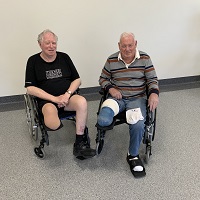Major lower limb amputation surgery
Lower limb amputation
After surgery
If the decision has been made for below knee or above knee amputation, then before the operation

Rehabilitation Physicians and Prosthetists can assist
with information and advice about what will happen afterwards. These types of amputation are more commonly performed in Hobart and Launceston.
Occupational Therapists can help you prepare for surgery, by looking at your home, and planning equipment and modifications you are likely to need when you return home. Social Workers can assist with social and emotional support, as well as considerations for applying for funding through the National Disability Insurance Scheme (when eligible).
Wound protection
After surgery, the health care team will work with you on protecting the surgery area from being knocked about, controlling swelling and helping with the shape of your leg.
Mobility
After surgery, getting around will be different.
It is important that you have a way of getting out of bed in the first few days after your surgery, as this helps prevent general complications of surgery and helps your recovery.
Your healthcare team may use special ways for you to get in and out of bed; and move from your bed to a chair. A wheelchair will be selected for you, and consider your size, your balance and care of your remaining limb.
Be aware that the team will focus on your ability to manage a wheelchair. They will work with you on how to return to home or another accommodation using a wheelchair.
Guidance will be provided on equipment funding options and any home modifications you are likely to need if returning home.
For further information please view the wheelchair mobility brochure
Rehabilitation
Whilst in hospital Rehabilitation teams may be asked to provide suggestions on:

- how to improve your recovery.
- whether you might benefit from spending time in a rehabilitation unit.
Inpatient rehabilitation units are where people are stay in a special hospital ward which provides more intensive rehabilitation than a standard ward to support your recovery.
On admission the rehabilitation team will work with you to set out goals for your time in rehabilitation.
The focus of these stays is to be able to return home at a manageable level of abilities.
There may be challenges to returning home and the team will partner with yourself, your family, friends, carers and other supportive people to help you have a smooth transition from hospital to home.
Prosthetic rehabilitation
Rehabilitation teams assess whether a prosthesis is suitable for you.

Some of the considerations include:
- Age and health conditions
- Physical abilities
- Thinking and cognitive abilities
- Condition of your remaining limbs
- Psychological factors
- Social supports
A prosthetic leg is not suitable for everyone.
Most prosthetic rehabilitation in Tasmania is conducted through Outpatient Rehabilitation programs.
Using a prosthesis involves training and education by several members of the team.
Initially the prosthesis remains at the therapy area between sessions.
It takes time to learn how to use a prosthesis.
Your skin and surgical wound healing may also restrict the training process.
